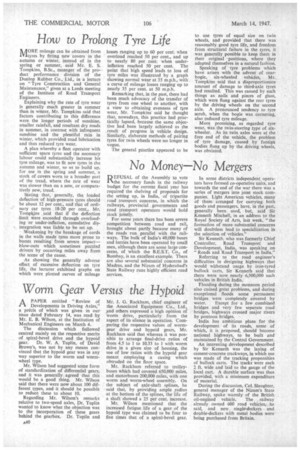No Money—No Mergers
Page 58

If you've noticed an error in this article please click here to report it so we can fix it.
REFUSAL of the Assembly to vote the necessary funds in the railway budget for the current fiscal year has required the shelving of proposals for the setting up, in India, of tripartite road transport concerns, in which the railways, provincial governments and road transport operators would hold stock jointly.
For some years there has been severe competition between road and rail, brought about partly because many of the roads run parallel with the railways. The bulk of India's 40,000 buses and lorries have been operated by small men, although there are some large concerns, of which the B.E.S.T. Co., of Bombay, is an excellent example. There are also several substantial concerns in Madras, and the Nizam of Hyderabad's State Railway runs highly efficient road services. In some districts independent operators have formed co-operative units, and towards the end of the war there was a series of mergers into joint stock cornpanies. Light American vehicles, many of them arranged for carrying both goods and passengers, have, in the past, generally been used; but, said Sir Kenneth Mitchell, in an address to the Royal Society of Arts, last week, "the formation of more substantial concerns will doubtless lead to specialization in the selection of vehicles."
Sir Kenneth. who was formerly Chief Controller, Road Transport and Development, India, was speaking on "Roads and Road Transport in India."
Referring to the road engineer's difficulties in designing highways that would withstand usage by iron-tyred bullock carts, Sir Kenneth said that there were now nearly 6,500,000 such vehicles in British India.
Flooding during the monsoon period also caUsed great problems, and during exceptional floods some permanent bridges were completely covered by water. Except for a few combined bridges and very few separate road bridges, highways crossed major rivers by pontoon bridges.
India has ambitious plans for the development of its roads, some of which, it is proposed, should become national highways, to be built and maintained by the Central Government.
An interesting development described by Sir Kenneth was the laying of cement-concrete trackways, in which use was made of the tracking propensities of bullock carts. The tracks were each 2 ft. wide and laid to the gauge of the local cart. A durable surface was thus provided, with a minimum expenditure of material.
During the discussion, Col. Slaughter, general manager of the Nizam's State Railway, spoke warmly of the British oil-engined vehicle. The railway already owned 600 road vehicles, he said, and new single-deckers and double-deckers with metal bodies were being purchased from Britain.




















































































